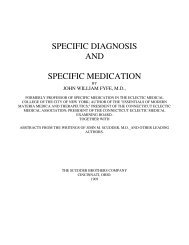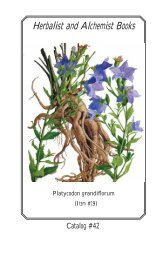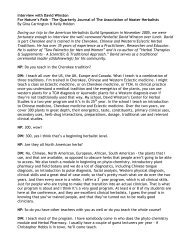MEDlCINAL PLANTS OF JAMAICA. PARTS 1 & 11.
MEDlCINAL PLANTS OF JAMAICA. PARTS 1 & 11.
MEDlCINAL PLANTS OF JAMAICA. PARTS 1 & 11.
You also want an ePaper? Increase the reach of your titles
YUMPU automatically turns print PDFs into web optimized ePapers that Google loves.
Beckwith mentions the use of the first three species to make tea for pains in the back and for use as a tonic. The<br />
juice is also said to remove warts. For gonorrhoea the plants are boiled with Phyllanthus niruri to make tea. In<br />
some parts milk weed tea is said to be good for high blood pressure. In the Grenadines E. hirta is thought to be a<br />
reliable cure for diarrhoea, and E. prostrata is used for the same purpose.<br />
Dalziel writes of E. hirta as known in medicine to be a remedy for asthma and inflammation of the<br />
respiratory tract, and called Australian or Queensland asthma weed.<br />
The tops contain gallic acid, quercetin, a phenol-like substance (C 28H l8O 15) sugar, triacontan, traces of<br />
ceryl alcohol. fatty acids, and traces of alkaloid. (2, 7, 13, 15, 27).<br />
JATROPHA CURCAS L. Physic Nut.<br />
According to Beckwith used in Jamaica as a purgative. In the Grenadines the leaves but rarely the seeds<br />
are so used. Curcas oil obtained from the seeds contains one or more toxic principles. At one time the toxic<br />
principle was said to be a toxalbumin named curcin similar to ricin and later work has assigned the toxicity to<br />
curcinoleic acid. (2, 5, 7, 10, 13, 14, 15, 23, 26, 27).<br />
JATROPHA GOSSYPIFOLIA L. Wild Cassada; Cassada Marble; Belly-ache Bush.<br />
Most of the old writers speak of the use of the leaves of this plant, either in decoction or boiled like<br />
spinach, as a purgative remedy for 'dry belly-ache'. Beckwith says it is used to prepare tea for constipation, the<br />
part used not being specified but it is probably the leaves. as given in the old remedies. The seeds are said to be<br />
purgative. the oil being similar to castor oil. Analyses of J. gossypifolia L. var. elegans Mull. indicate the<br />
presence in the bark of an alkaloid, jatrophin, (C14Hzo06N), which is slightly toxic. Resins, tannins and<br />
phytosterin (CZ7H460) are also present. (2, 5, 7, 15, 27).<br />
PHYLLANTHUS NIRURI L. Carry-me-seed; Quinine Weed.<br />
This plant is commonly used throughout the West Indies and in India as a remedy for fevers. It is also<br />
sometimes used for genito-urinary infections and, in Jamaica. in combination with milk weed, it is said to be<br />
good for gonorrhoea. The root and leaves have also been made into infusions as a cure for dysentery, diabetes.<br />
jaundice, stomach-ache, as a diuretic, and in dropsical complaints. The bark contains a crystalline bitter<br />
principle. phyllanthin (C 30H 370 8) and the leaves are rich in potassium salts. (2. 7. 13, 14. 27).<br />
RICINUS COMMUNIS L. Castor Oil Plant.<br />
Castor oil is used in the usual manner, in Jamaica. as a purge. It is also used with Capsicum leaves as a<br />
dressing for boils. and the leaves of the plant are tied on as a cool dressing for a headache. Similar use is made<br />
of the oil and leaves in the Transvaal. Browne said that the root was regarded as a diuretic. In some parts of<br />
Africa leaf infusions are used for stomach-ache, as a lactagogue and emmenagogue, and as a purge. A root paste<br />
is made by the Zulus for treating toothache, and some tribes use the leaves to make eye lotion, a lotion for<br />
fevers and a poultice for swellings.<br />
The principle constituents of the oil are the glycerides of ricinoleic (?isoricinoleic) stearic,<br />
dihydroxystearic, oleic and linoleic acids. The purgative action has been ascribed to free ricinoleic and its<br />
isomeric acid produced by hydrolysis in the duodenum. The seed also contains various albuminous compounds,<br />
an alkaloid, ricin in (CsHS02N2); and the toxic principle, ricin, which is a severe irritant and agglutinant and<br />
has been variously described as an alkaloid, toxalbumin and phytalbumose. The leaves are said to contain, in<br />
addition to the alkaloid ricinin, a crystalline bitter substance (C24HH2N70) which is not an alkaloid. (3, 5, 7,<br />
10, 15, 18, 23, 24, 26, 27).<br />
FILICINEAE<br />
DRYOPTERIS SP. White Stick.<br />
Said, by Beckwith, to be used for colds and as a general panacea. (See Anacardium occidentale). (2).







